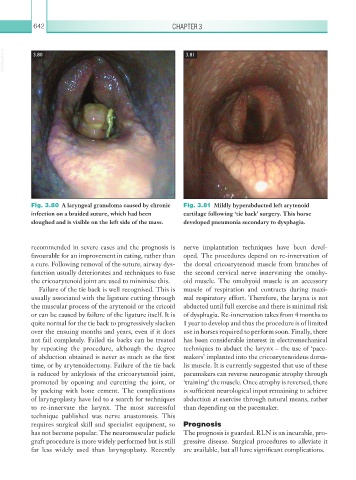Page 667 - Equine Clinical Medicine, Surgery and Reproduction, 2nd Edition
P. 667
642 CHAPTER 3
VetBooks.ir 3.80 3.81
Fig. 3.80 A laryngeal granuloma caused by chronic Fig. 3.81 Mildly hyperabducted left arytenoid
infection on a braided suture, which had been cartilage following ‘tie back’ surgery. This horse
sloughed and is visible on the left side of the mass. developed pneumonia secondary to dysphagia.
recommended in severe cases and the prognosis is nerve implantation techniques have been devel-
favourable for an improvement in eating, rather than oped. The procedures depend on re-innervation of
a cure. Following removal of the suture, airway dys- the dorsal cricoarytenoid muscle from branches of
function usually deteriorates and techniques to fuse the second cervical nerve innervating the omohy-
the cricoarytenoid joint are used to minimise this. oid muscle. The omohyoid muscle is an accessory
Failure of the tie back is well recognised. This is muscle of respiration and contracts during maxi-
usually associated with the ligature cutting through mal respiratory effort. Therefore, the larynx is not
the muscular process of the arytenoid or the cricoid abducted until full exercise and there is minimal risk
or can be caused by failure of the ligature itself. It is of dysphagia. Re-innervation takes from 4 months to
quite normal for the tie back to progressively slacken 1 year to develop and thus the procedure is of limited
over the ensuing months and years, even if it does use in horses required to perform soon. Finally, there
not fail completely. Failed tie backs can be treated has been considerable interest in electromechanical
by repeating the procedure, although the degree techniques to abduct the larynx – the use of ‘pace-
of abduction obtained is never as much as the first makers’ implanted into the cricoarytenoideus dorsa-
time, or by arytenoidectomy. Failure of the tie back lis muscle. It is currently suggested that use of these
is reduced by ankylosis of the cricoarytenoid joint, pacemakers can reverse neurogenic atrophy through
promoted by opening and curetting the joint, or ‘training’ the muscle. Once atrophy is reversed, there
by packing with bone cement. The complications is sufficient neurological input remaining to achieve
of laryngoplasty have led to a search for techniques abduction at exercise through natural means, rather
to re-innervate the larynx. The most successful than depending on the pacemaker.
technique published was nerve anastomosis. This
requires surgical skill and specialist equipment, so Prognosis
has not become popular. The neuromuscular pedicle The prognosis is guarded. RLN is an incurable, pro-
graft procedure is more widely performed but is still gressive disease. Surgical procedures to alleviate it
far less widely used than laryngoplasty. Recently are available, but all have significant complications.

